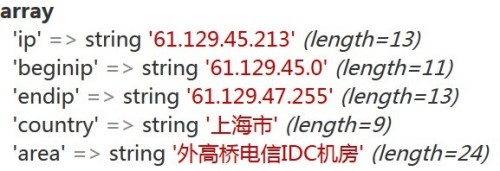ThinkPHP使用UTFWry地址库进行IP定位实例_php实例
可以在官网的 http://www.thinkphp.cn/extend/223.html下载IP定位扩展类库,或者下载扩展包( http://www.thinkphp.cn/down/253.html)里面也已经包含该扩展类了。如果是单独下载的上传类库,把解压后的IpLocation.class.php 放入ThinkPHP/Extend/Library/ORG/Net/(如果没有请手动创建)目录下面。
一、获取IP地址
如果你仅仅需要获取用户访问的IP地址,那么直接使用系统内置的get_client_ip函数即可,该函数是ThinkPHP标准模式内置方法,可以直接使用,比PHP内置的系统变量$_SERVER['HTTP_CLIENT_IP']具有更好的兼容性,用法:
get_client_ip支持IP地址的多种情况检测和合法性验证,返回值就是获取到的IP地址,如果获取到的IP地址非法,将返回0.0.0.0。
如果需要,也可以返回IPV4地址数字,例如:
返回的结果可能类似于:
可用于地址范围和比较。
二、IP地址定位
仅仅获取IP地址并不能完全满足应用的需求,只能记录下来用于日后的日志分析需要,IP地址定位功能可以让你获取用户的所在区域。要使用IP定位功能,除了需要IpLocation扩展类库之外,还需要IP地址库文件,由于ThinkPHP默认采用UTF8编码,因此最好是UTF8格式的IP地址库文件,如果是纯真gbk编码的IP地址库文件,则需要对获取结果进行编码转换(下面会提到),可以在这里下载UTF8编码的地址库文件: http://www.thinkphp.cn/extend/270.html
解压后的地址库文件UTFWry.dat放入IpLocation扩展类库所在目录下面即可。
使用方法:
$Ip = new IpLocation(); // 实例化类
$location = $Ip->getlocation('218.79.93.194'); // 获取某个IP地址所在的位置
返回的location变量是一个数组,包括:
$location['beginip'] // 用户IP所在范围的开始地址
$location['endip'] // 用户IP所在范围的结束地址
$location['country'] // 所在国家或者地区
$location['area'] // 所在区域
通常,我们要获取IP定位的话,只需要取country和area信息:
如果你使用的IP地址库文件不是UTFWry.dat(注意在Linux下面文件名的大小写也需要一致)的话,我们需要在实例化IpLocation类的时候传入地址库文件名,例如:
如果你的IP地址库是GBK编码的话,需要对返回结果进行编码转换。例如:
如果调用getlocation方法的时候没有传入任何参数,系统会自动调用上面的get_client_ip函数获取当前所在IP地址:
也可以支持传入域名来自动获取ip地址
$Ip = new IpLocation(); // 实例化类
$area = $Ip->getlocation('www.thinkphp.cn'); // 获取域名服务器所在的位置
dump($area);
运行结果输出:

如果大家使用的是纯真IP地址库,或者经常需要变换不同的地址库,为了方便IP定位的查询,也可以单独封装一个函数来获取位置信息,参考这里: http://www.thinkphp.cn/code/88.html

Hot AI Tools

Undresser.AI Undress
AI-powered app for creating realistic nude photos

AI Clothes Remover
Online AI tool for removing clothes from photos.

Undress AI Tool
Undress images for free

Clothoff.io
AI clothes remover

AI Hentai Generator
Generate AI Hentai for free.

Hot Article

Hot Tools

Notepad++7.3.1
Easy-to-use and free code editor

SublimeText3 Chinese version
Chinese version, very easy to use

Zend Studio 13.0.1
Powerful PHP integrated development environment

Dreamweaver CS6
Visual web development tools

SublimeText3 Mac version
God-level code editing software (SublimeText3)

Hot Topics
 How to run thinkphp project
Apr 09, 2024 pm 05:33 PM
How to run thinkphp project
Apr 09, 2024 pm 05:33 PM
To run the ThinkPHP project, you need to: install Composer; use Composer to create the project; enter the project directory and execute php bin/console serve; visit http://localhost:8000 to view the welcome page.
 There are several versions of thinkphp
Apr 09, 2024 pm 06:09 PM
There are several versions of thinkphp
Apr 09, 2024 pm 06:09 PM
ThinkPHP has multiple versions designed for different PHP versions. Major versions include 3.2, 5.0, 5.1, and 6.0, while minor versions are used to fix bugs and provide new features. The latest stable version is ThinkPHP 6.0.16. When choosing a version, consider the PHP version, feature requirements, and community support. It is recommended to use the latest stable version for best performance and support.
 How to run thinkphp
Apr 09, 2024 pm 05:39 PM
How to run thinkphp
Apr 09, 2024 pm 05:39 PM
Steps to run ThinkPHP Framework locally: Download and unzip ThinkPHP Framework to a local directory. Create a virtual host (optional) pointing to the ThinkPHP root directory. Configure database connection parameters. Start the web server. Initialize the ThinkPHP application. Access the ThinkPHP application URL and run it.
 Which one is better, laravel or thinkphp?
Apr 09, 2024 pm 03:18 PM
Which one is better, laravel or thinkphp?
Apr 09, 2024 pm 03:18 PM
Performance comparison of Laravel and ThinkPHP frameworks: ThinkPHP generally performs better than Laravel, focusing on optimization and caching. Laravel performs well, but for complex applications, ThinkPHP may be a better fit.
 How to install thinkphp
Apr 09, 2024 pm 05:42 PM
How to install thinkphp
Apr 09, 2024 pm 05:42 PM
ThinkPHP installation steps: Prepare PHP, Composer, and MySQL environments. Create projects using Composer. Install the ThinkPHP framework and dependencies. Configure database connection. Generate application code. Launch the application and visit http://localhost:8000.
 Development suggestions: How to use the ThinkPHP framework to implement asynchronous tasks
Nov 22, 2023 pm 12:01 PM
Development suggestions: How to use the ThinkPHP framework to implement asynchronous tasks
Nov 22, 2023 pm 12:01 PM
"Development Suggestions: How to Use the ThinkPHP Framework to Implement Asynchronous Tasks" With the rapid development of Internet technology, Web applications have increasingly higher requirements for handling a large number of concurrent requests and complex business logic. In order to improve system performance and user experience, developers often consider using asynchronous tasks to perform some time-consuming operations, such as sending emails, processing file uploads, generating reports, etc. In the field of PHP, the ThinkPHP framework, as a popular development framework, provides some convenient ways to implement asynchronous tasks.
 ThinkPHP6 backend management system development: realizing backend functions
Aug 27, 2023 am 11:55 AM
ThinkPHP6 backend management system development: realizing backend functions
Aug 27, 2023 am 11:55 AM
ThinkPHP6 backend management system development: Implementing backend functions Introduction: With the continuous development of Internet technology and market demand, more and more enterprises and organizations need an efficient, safe, and flexible backend management system to manage business data and conduct operational management. This article will use the ThinkPHP6 framework to demonstrate through examples how to develop a simple but practical backend management system, including basic functions such as permission control, data addition, deletion, modification and query. Environment preparation Before starting, we need to install PHP, MySQL, Com
 How is the performance of thinkphp?
Apr 09, 2024 pm 05:24 PM
How is the performance of thinkphp?
Apr 09, 2024 pm 05:24 PM
ThinkPHP is a high-performance PHP framework with advantages such as caching mechanism, code optimization, parallel processing and database optimization. Official performance tests show that it can handle more than 10,000 requests per second and is widely used in large-scale websites and enterprise systems such as JD.com and Ctrip in actual applications.






